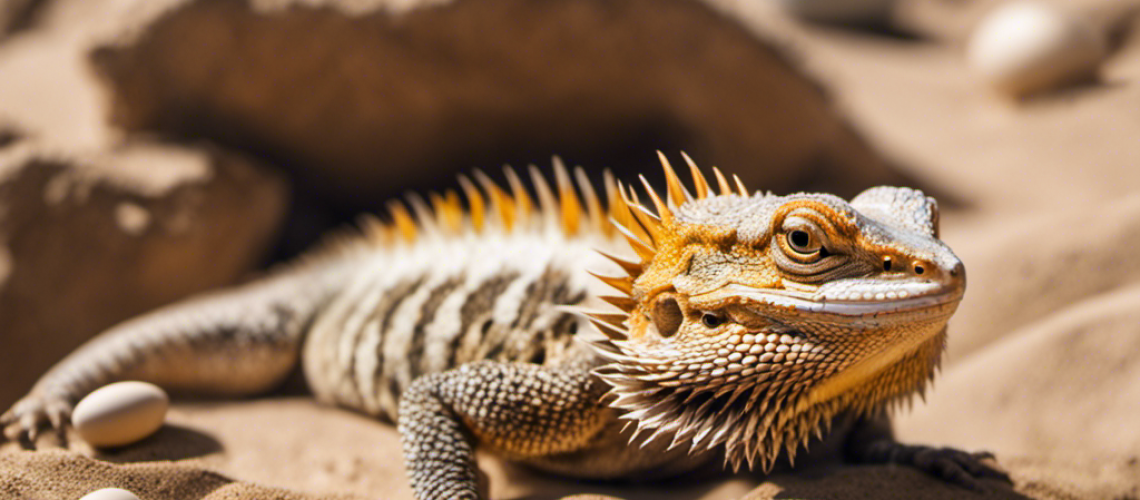Bearded dragons, or Pogona Vitticeps, are a type of lizard native to Australia and part of the Agamidae family.
Breeding season for these animals occurs in different times depending on their local climate and environmental conditions.
This article will explore when bearded dragon breeding season happens, how to prepare for it, and the factors that influence it.
Additionally, this article will also cover successful methods of ensuring a successful breeding experience.
Key Takeaways
- Bearded dragon breeding season typically occurs during the warm spring months and is regulated by temperature control.
- Males exhibit aggressive mating rituals and territorial behavior to compete for access to females.
- The breeding season usually begins in late winter or early spring and can last until May or June.
- Factors such as temperature, humidity levels, and diet quality are crucial for successful breeding.
What Is Bearded Dragon Breeding Season
Bearded dragon breeding season is a period of time in which the species engages in reproductive activities. This season is largely regulated by temperature control and typically takes place during the warm spring months.
During this time, male dragons will engage in aggressive mating rituals to compete for access to females. The males will also exhibit territorial behavior as they attempt to protect their chosen partner.
Females typically lay clutches of eggs during this period, which can then be incubated and hatched at a later point in the year.
When Does Breeding Season Occur
The optimum period for procreation of this species typically occurs annually. Breeding behavior is triggered by various environmental factors, such as increased temperatures and longer days.
For bearded dragons, the breeding season usually begins in late winter or early spring and can last until May or June. During this time, eggs are laid and incubation takes place until the hatchlings emerge. Temperatures must remain constant during egg incubation to ensure a successful outcome.
Proper care is essential for successful breeding season results when keeping bearded dragons at home.
Preparing for Breeding Season
In preparation for successful procreation, environmental factors must be taken into account. Sexing dragons is an important part of preparing for the breeding season, and should be done at least a month prior.
As bearded dragons are ectothermic animals, temperature plays a large role in successful breeding; providing conditions such as optimal temperatures for basking and cooling down will help regulate hormones and encourage reproductive behaviors.
Humidity levels should also be monitored carefully to ensure that it remains between 40-50%.
Additionally, creating an environment free from stressors is critical to increasing the chance of success during the breeding season.
Factors Affecting Breeding Season
Environmental conditions play a significant role in facilitating reproductive behavior during the mating period.
Temperature control, diet quality, and humidity levels are all important environmental factors that can influence bearded dragon breeding season.
Mating rituals may be altered or disrupted if temperatures become too cold or hot.
High-quality diets with adequate nutrition are also necessary for successful mating.
Lastly, humidity levels should remain consistent, as sudden changes can affect the ability of dragons to reproduce successfully.
Ensuring Successful Breeding Season
Successful mating can be achieved by providing the appropriate environmental conditions during a breeding season. This includes ensuring the correct sex ratio, temperature, humidity levels, and light cycle for bearded dragons.
Additionally, setting up a suitable area for mating rituals is essential to successful breeding. Sex selection is an important factor in determining which dragon will mate with which one as female bearded dragons tend to choose their own mates.
Frequently Asked Questions
How Often Should I Feed My Bearded Dragon During Breeding Season?
When monitoring diet and light cycles during breeding season, it is important to feed bearded dragons regularly. Offer a variety of foods and monitor their intake to ensure they are receiving the proper nutrition. Adjustment in feeding may be necessary for successful breeding.
What Signs Indicate That My Bearded Dragon Is Ready to Breed?
Bearded dragons display certain behaviors when ready to mate, such as increased social interaction with other dragons and more frequent courtship rituals. These behaviors can include head bobbing, arm waving, and tail twitching. Paying close attention to these signs is important for successful breeding.
What Type of Housing Do I Need to Provide for Breeding Bearded Dragons?
When breeding bearded dragons, it is important to provide adequate housing that allows for socialization and triggers the breeding behavior. Housing should be spacious enough for two or more dragons, with multiple levels and hiding places for each. Temperature, humidity, and light must also be carefully controlled.
Are There Any Specific Requirements for the Temperature and Humidity of My Bearded Dragon Enclosure During Breeding Season?
Brumation signs in bearded dragons indicate the onset of breeding season. During this time, mating rituals and other behaviors are observed. To ensure successful reproduction, proper enclosure conditions must be maintained. Temperature should range from 78-88°F with humidity levels between 30-50%.
What Should I Do if My Bearded Dragon Is Not Reproducing During Breeding Season?
Mating rituals and breeding behavior can be affected by a variety of factors. If a bearded dragon is not reproducing during the breeding season, it may be beneficial to observe the enclosure’s temperature and humidity levels, as well as other environmental conditions. Additionally, changes in diet can influence mating behavior which should be considered.
Conclusion
While the timing of bearded dragon breeding season can vary, there are certain factors which need to be taken into account when preparing for a successful breeding season.
It is important to consider the environment in which the dragon will breed, as well as their age and health status.
Furthermore, it is essential that appropriate nutrition and housing conditions are provided in order to ensure successful mating.
With careful preparation and consideration of these factors, a successful breeding season can be achieved.






